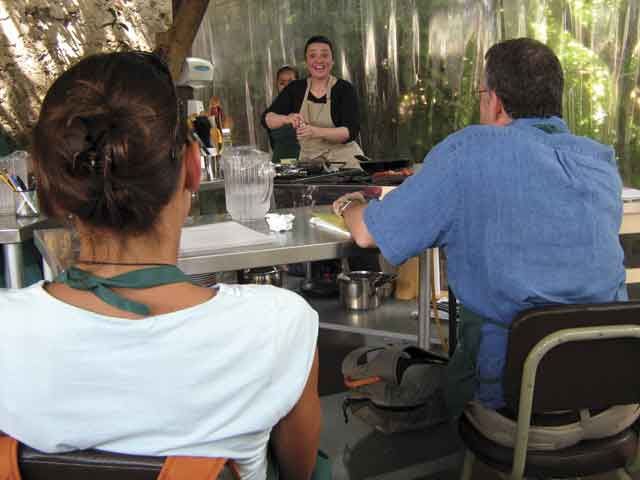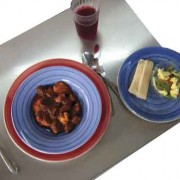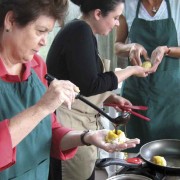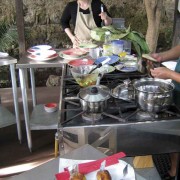Cooking With Class

Instructor Militza de León teaches a new menu every day with hands-on experience (photo: Jack Houston)
Written by Dianne Carofino
Where the excuse “I ate my homework” actually works
Outdoor dining at its best: under a 130-year-old avocado tree in the walled garden of a La Antigua colonial home. The menu? Traditional Guatemalan dishes: subanik—a four-meat stew with a spicy sauce of puréed roasted tomatoes and red peppers, white-dough tamal to soak up that rich sauce and escabeche, a cooked vegetable salad served at room temperature. More about the food later—we haven’t gotten to dessert yet. On to our dinner companions: four congenial travelers and La Antigua residents sharing their Guatemala experiences—its food, its history and its traditions. A private dinner party? No. An expensive restaurant? No. The Antigua Cooking School.
Militza de León, a graduate of the Intecap Guatemalan culinary school, and Vilma McComsey, proprietor of The Antigua Cooking School, provide this setting and hands-on experience five days a week in central La Antigua. On the day I attended, Militza was the instructor. She resembled a casual hostess who had invited her guests into the kitchen to chat as she prepared our meals, thoughtfully providing each of us with a copy of her recipes to take home.
Conversation first focused on Militza’s preferred preparation of black beans—enough for the week, unseasoned and stashed away in the freezer in small containers. The beans may then be used as needed in the preparation of any number of different dishes, including that dessert we haven’t yet tackled. We sampled whole bean soup (frijoles parados), black bean puréed soup (frijoles colados), and fried beans (frijoles volteados) at various stages of preparation (before the addition of salt, for example) to experience the effect of additional ingredients as the dishes were prepared.As invariably happens when guests dare to chat with the hostess in the kitchen, we were put to work. Militza gave us aprons and prepared dough and demonstrated how to make the tortillas needed for the meal. If you are picturing yourself rapidly patting dough back and forth between your palms, like the talented ladies in the restaurants and shops of La Antigua, you may be as surprised as I was by the reality of tortilla making.
Even though I conscientiously tried to follow Militza’s instructions, the dough stuck to my palms, creating holes in my tortilla; and the tortillas didn’t stay in that even circular shape but had edges resembling a rocky coast line. One tortilla folded on itself like an omelet as it was flipped on the griddle. Then, with a smile, Militza did a little something and the tortillas looked like tortillas. The edges were still uneven, but they looked edible, even inviting. Of course, we all got to eat our tortillas, with frijoles volteados and the guacamole which we had watched Militza make. Delicioso.
 Entradas over, it was time for dinner. As Militza prepared subanik, she discussed the dish to explore other interesting topics about the various cultures of Guatemala. Originally a ceremonial dish of Chimaltenango, prepared with large pieces of meat wrapped in a salt leaf and steamed in the ground, the stew is traditionally served with tamalitos blancos. Subanik might be loosely translated ‘spicy white dough’.
Entradas over, it was time for dinner. As Militza prepared subanik, she discussed the dish to explore other interesting topics about the various cultures of Guatemala. Originally a ceremonial dish of Chimaltenango, prepared with large pieces of meat wrapped in a salt leaf and steamed in the ground, the stew is traditionally served with tamalitos blancos. Subanik might be loosely translated ‘spicy white dough’.
Today’s preparation modified the traditional on a number of counts. Three meats (tenderloin beef, chicken and turkey breasts) and the prepared sauce were steamed in Mashán leaves in the oven. The large leaves, which can be purchased in the market, were washed and arranged in a deep pot. The stew was then added on top of the leaves, which were tied decoratively with cibaque, a plant fiber used as a heavy string.
Throughout the afternoon, while Militza used natural and traditional ingredients to the delight of her guests, she carefully modified her methods, both conversationally and in her written recipes, to accommodate settings in which these ingredients might not be available. A Dutch oven, although not providing the unexpected charm of the Mashán leaves tied with cibaque, can also be used to prepare the subanik.

Classmates Dianne Carofino (left) and Paige Keck (right) get pointers from instructor Militza de León (photo: Jack Houston)
Preparation for dessert, rellenitos, put us all to back to work, with our hands in the plantain dough. The recipe for the sauce, which is cooked inside the plantain dough and then also poured over the rellenitos, begins with a surprise ingredient: 2 cups whole, unsalted, cooked black beans. Only 2 Tbs. of grated Guatemalan chocolate is used in a recipe which serves 10. If I had not participated in preparing this delicious dish, I would have thought I had eaten much more chocolate and been surprised by the black beans. Again, delicioso!
As we left, each of the group seemed to be thinking of ways to take our knowledge home with us. Paige was mulling over the amount of black beans to prepare for the week, back in Jersey City. I was trying to decide which of the other four menus I would try next—a different menu is presented each day of the week. Perhaps enchiladas on a Monday, or maybe tamales on Wednesday. But then, Pepián is so traditional to Guatemala, and that is Friday’s menu.
Antigua Cooking School is located at 5a av. norte #25-B (tel: 5990-3366) Online: www.antiguacookingschool.com
